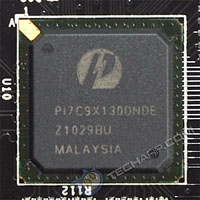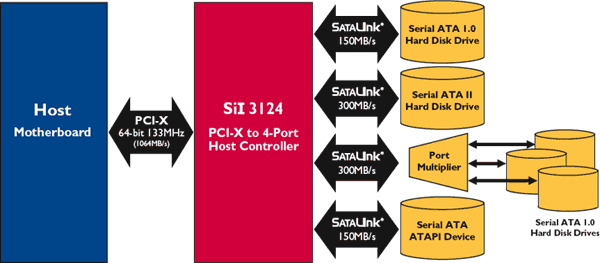The Controllers
OCZ went off the beaten path with the RevoDrive's design. They essentially created two solid state drives on the card, each powered by a SandForce SF-1222 controller. They then used the Silicon Image SiI 3124 PCI-X-to-SATA RAID controller to create a RAID 0 array from the two solid state drives. The end result is a single solid state drive with twice the throughput.
 |
 |
 |
The Silicon Image SiI 3124 is an odd choice because it is not a PCI Express SATA controller. Instead, it supports either the PCI-X bus or the PCI bus. To convert the RevoDrive into a PCI Express card, OCZ used the Pericom PI7C9X130 PCIe-to-PCI-X reversible bridge chip. This allows the Silicon Image SiI 3124 controller to communicate with the CPU via the PCI Express x4 interconnect.

The PCI-X bus delivers the same amount of bandwidth (1 GB/s) as PCI Express x4 Rev. 1.1, but because the Pericom bridge adds some additional latency, there is some impact on real world performance. However, the maximum bandwidth provided by either PCI-X or PCI Express x4 is far in excess of what the RevoDrive is designed to achieve, which is 540 MB/s. In addition, this roundabout method is said to greatly reduce cost, allowing OCZ to deliver the RevoDrive at a more affordable price point.
Flash Memory
 |
 |
The OCZ RevoDrive uses the Intel 29F32G08AAMDB, which is a 34 nm MLC (Multi-Level Cell) chip with a 4 GB storage capacity. There are 24 of these MLC NAND chips, giving the OCZ RevoDrive a total storage capacity of 96 GB.
The RevoDrive has a usable storage capacity of 80 GB, which means there is over-provisioning of 20%. Over-provisioning of the NAND flash memory increases write IOPS performance by providing pre-erased blocks ready for use in the virtual pool of flash memory. It also increases the perceived lifespan of the solid state drive by swapping bad blocks that develop over time with spare blocks.
Incidentally, the OCZ RevoDrive uses a 4 Mbit (512 KB) SST 39VF040 CMOS flash memory chip for firmware storage.
SSD Maintenance
First of all, you should never, ever defragment solid state drives using the usual hard disk drive defragmentation software. Spatial fragmentation of data has no effect on SSD performance - fragmented bits of data are accessed just as quickly as nicely packed blocks, so it is pointless to "defragment" the data blocks in the traditional sense. Doing so will also reduce the flash memory cells' lifespan by putting them under additional wear. Remember - MLC flash memory will only last about 10,000 erase/write cycles.
Unlike hard disk drives, flash-based SSDs write and overwrite data in large blocks of 512 KB to 1 MB in size. Even if you only need to overwrite one byte of data, it has to erase and overwrite an entire block. This causes a lot of wear on the memory cells and greatly reduces their lifespan. To prevent that from happening, SSDs perform wear leveling by spreading the writes so that the flash memory cells have equal wear.
To further improve lifespan and performance, some SSDs use an SDRAM write buffer to temporarily store and combine writes before they are actually written to the flash memory. This reduces the number of block erases required and increases the memory cells' lifespan. SandForce controllers do not use such a write buffer to reduce cost and complexity. Instead, they use on-the-fly data compression to reduce the amount of data to be written to the flash memory.
As helpful as wear leveling and the write combine buffer (or on-the-fly data compression) are, they cannot address the issue of "dirty" blocks, which will develop over time. Most operating systems will not directly inform the SSD which data blocks have been deleted. They will merely flag the deleted data blocks in their file system so they can be overwritten by new data.
Unlike the magnetic media in hard disk drives though, the NAND flash memory cells in solid state drives can only be written to if they are empty. Cells that contain data (even useless, deleted data) must be erased before any new data can be written to it. This requires the SSD to perform the time-consuming read-erase-modify-write cycle to overwrite the "dirty" block, which not only cripples performance but also increases wear on the affected memory cells.
To counter this, newer SSDs support the TRIM command, otherwise known as the ATA8-ACS-2 DATA SET MANAGEMENT command. Operating systems that support TRIM (e.g. Microsoft Windows 7) will notify the solid state drive when data blocks are deleted in the file system. This allows the solid state drive to perform garbage collection in the background - internally erase the affected blocks so that they are ready to be written to.
Unfortunately, the OCZ RevoDrive does not support TRIM as it is a RAID array. Instead, OCZ employs internal garbage collection on a periodical basis to clean up "dirty" blocks for optimal performance.
Support Tech ARP!
If you like our work, you can help support out work by visiting our sponsors, participate in the Tech ARP Forums, or even donate to our fund. Any help you can render is greatly appreciated!
Page |
Topic |
|
1 |
|
|
2 |
||
3 |
||
4 |
||
5 |
||
6 |
||
7 |
||
8 |
||
9 |
||
10 |
||
11 |
||
12 |
||
13 |
||
14 |
||
<<< The RevoDrive 80 GB SSD, Usable Capacity, Specifications : Previous Page | Next Page : Testing The OCZ RevoDrive >>>







 Add to Reddit
Add to Reddit
